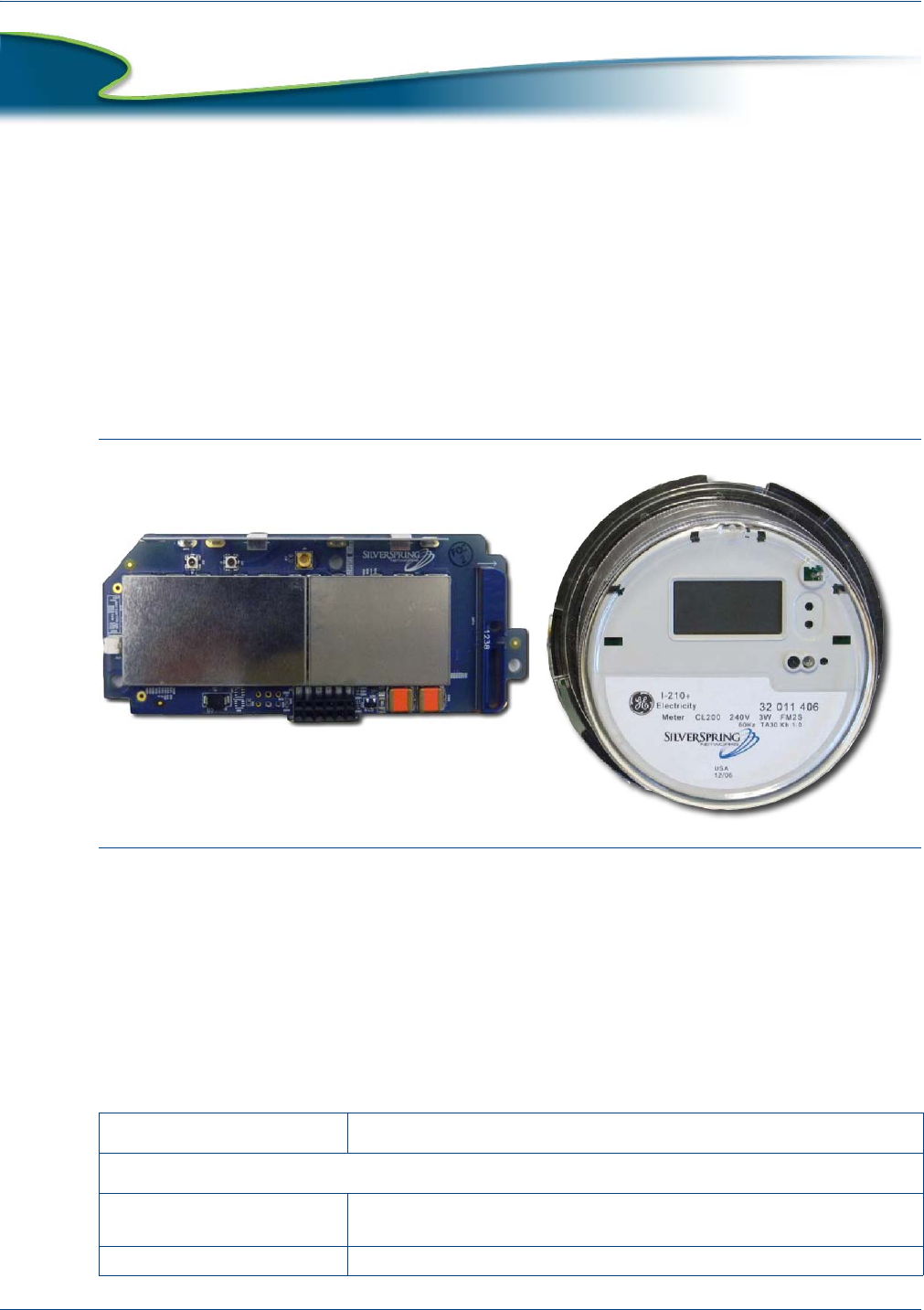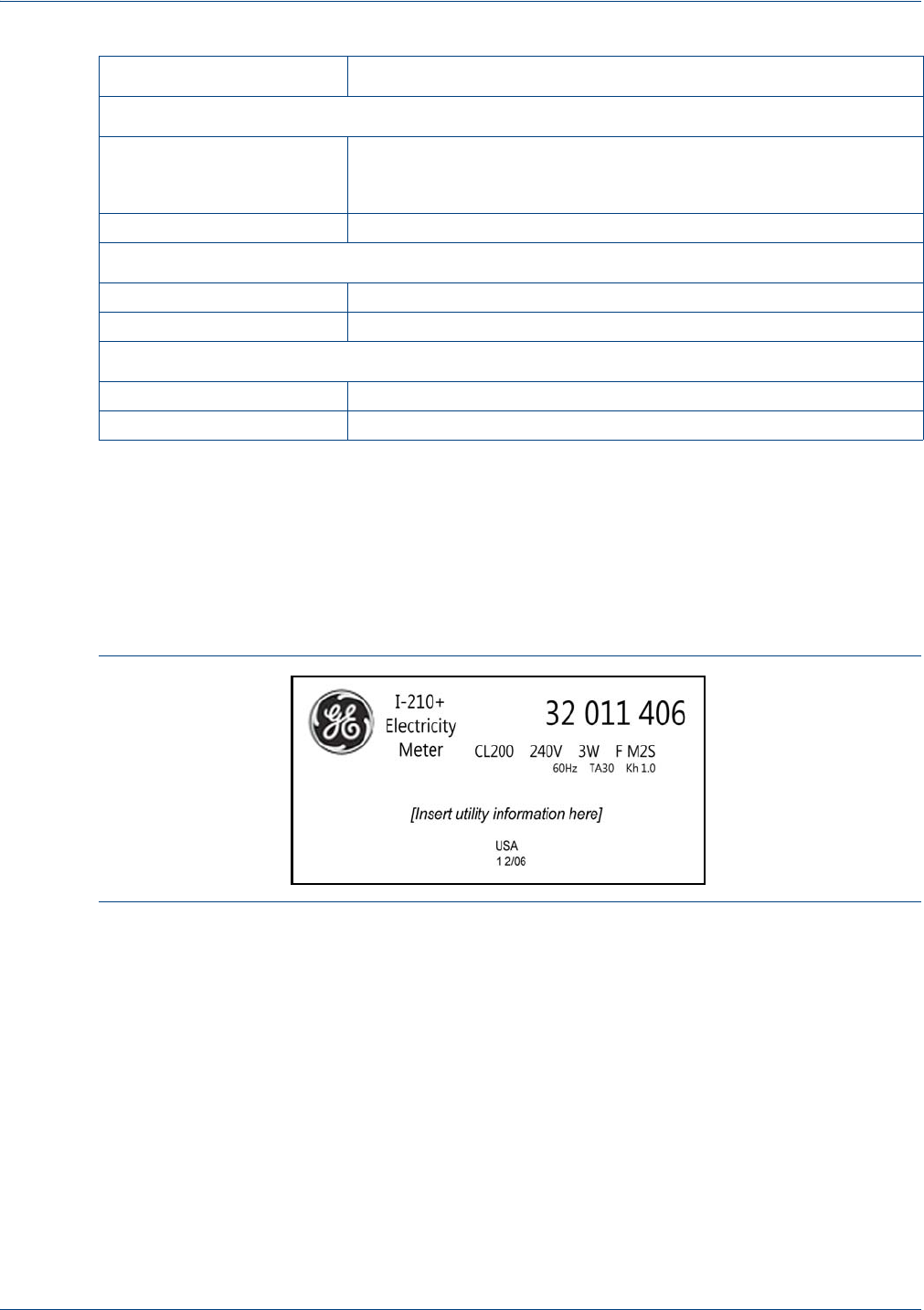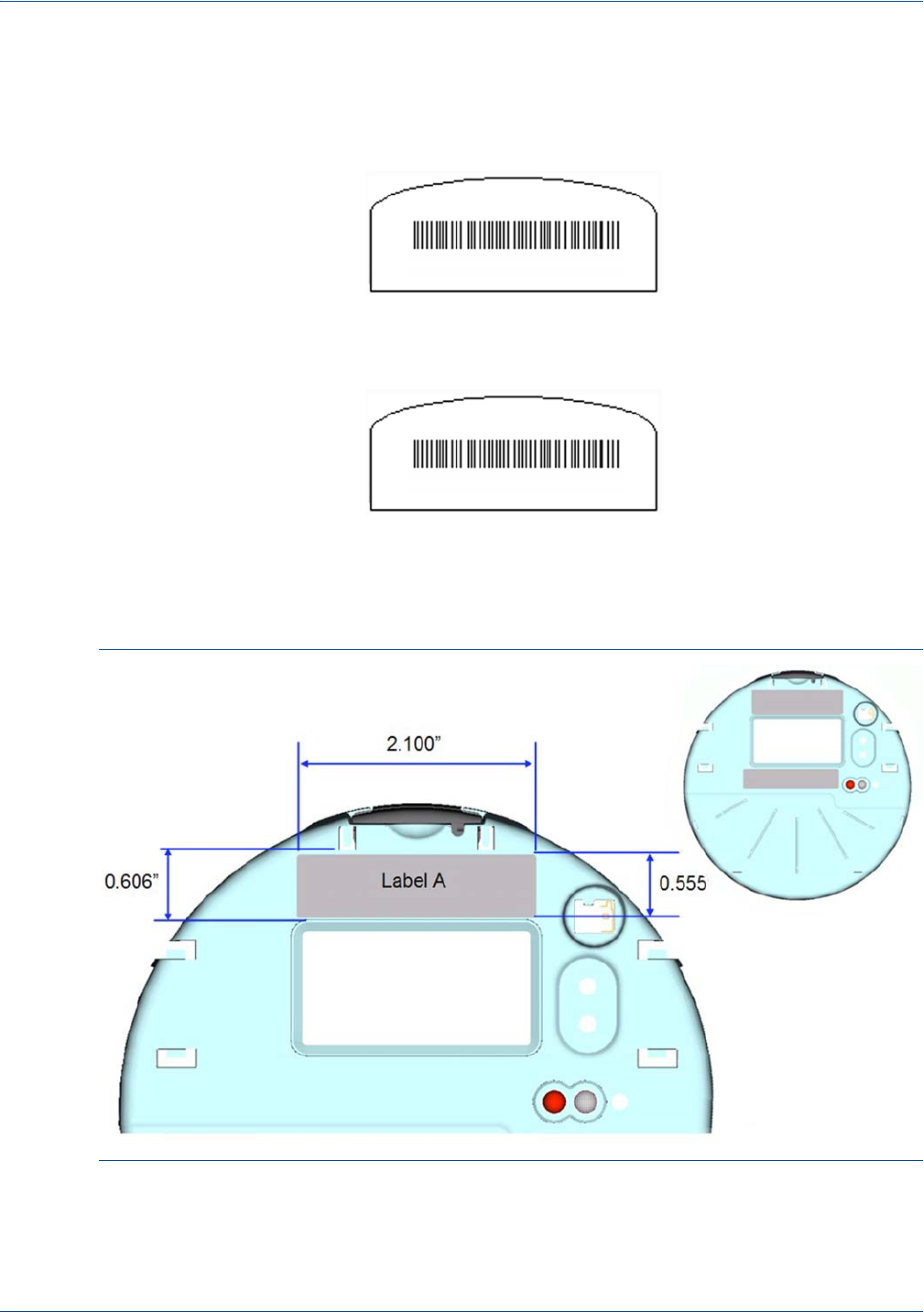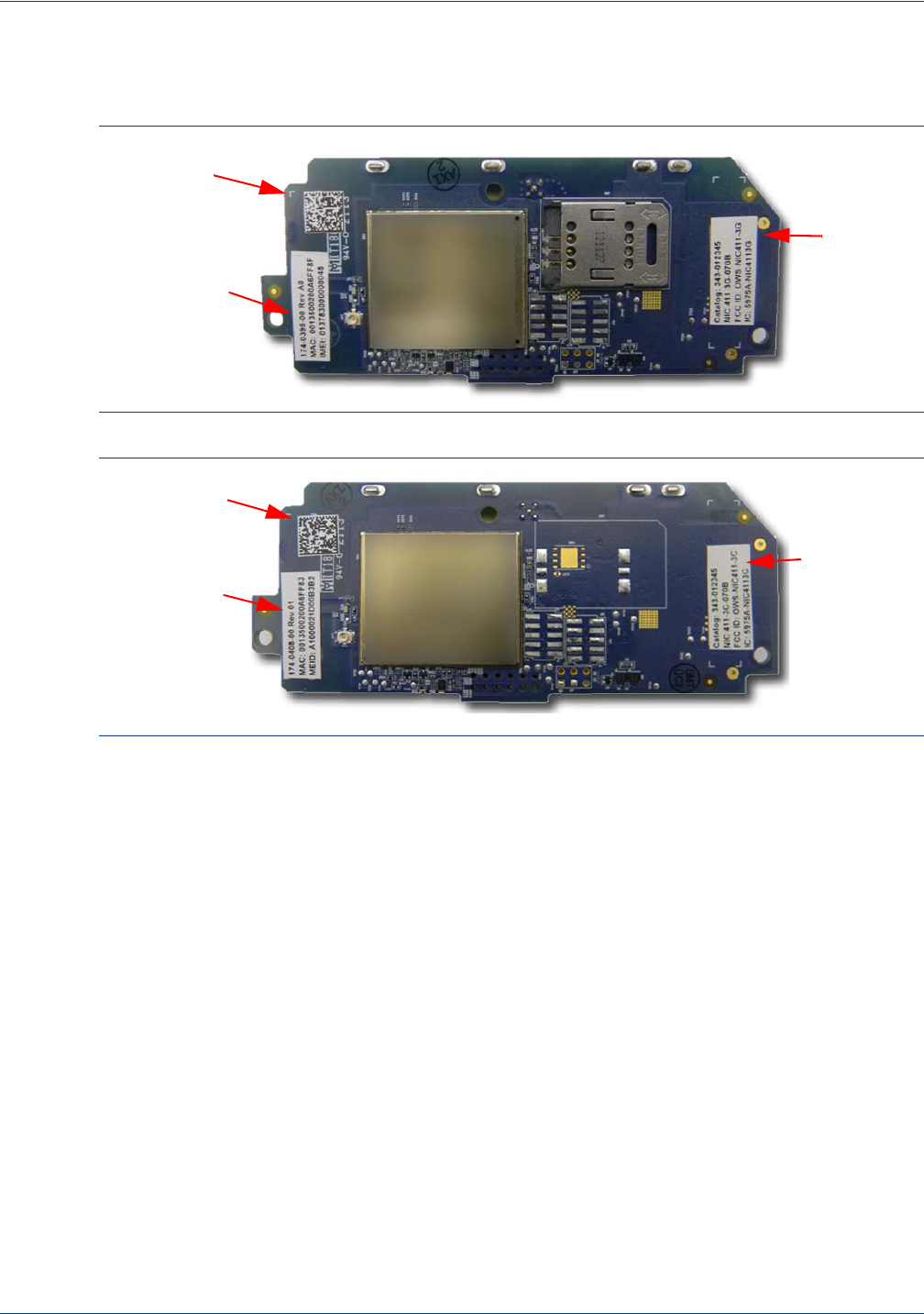Itron NIC411-3G MicroAP NIC module for electric meter User Manual MicroAP 4113G User Guide
Silver Spring Networks MicroAP NIC module for electric meter MicroAP 4113G User Guide
Itron >
Manual

Confidential Information of Silver Spring Networks, Inc., provided under nondisclosure obligations.
Copyright © 2013 Silver Spring Networks, Inc. All rights reserved.
The Silver Spring Networks logo, UtilityIQ®, and UtilOS® are registered trademarks of Silver Spring Networks, Inc.
GridScape™, CustomerIQ™, and Direct-to-Grid™ are trademarks of Silver Spring Networks, Inc.
All other company and product names are used for identification purposes only and may be registered trademarks,
trademarks, or service marks of their respective owners.
Please consider the environment before printing this document.
Customer Support
Telephone Hours Email
Toll free within the US and Canada:
1-888-SSN-9876
(1-888-776-9876)
Non-toll-free: 1-650-298-4298
5:00 AM - 6:00 PM
US Pacific Time
support@silverspringnet.com
In Australia:
1300 706 769
9:00 AM - 9:00 PM
Australia Eastern Time
aus-support@silverspringnet.com
Contact us on the Web: http://www.silverspringnet.com/services/customer-support/
MicroAP (NIC 411-3G and 411-3C) and Meter Labeling 7 August 2013 Silver Spring Networks 2
MicroAP (NIC 411-3G and 411-3C) and Meter Labeling

MicroAP (NIC 411-3G and 411-3C) and Meter Labeling 7 August 2013 Silver Spring Networks 3
MicroAP (NIC 411-3G and 411-3C) and Meter Labeling Contents
Contents
1. About the NIC 411-3G and 411-3C . . . . . . . . . . . . . . . . . . . . . . . . . . . . . . . . . . . . . . . . . . . . 4
References . . . . . . . . . . . . . . . . . . . . . . . . . . . . . . . . . . . . . . . . . . . . . . . . . . . . . . . . . . . . . . . . . . . . . . 4
Specifications . . . . . . . . . . . . . . . . . . . . . . . . . . . . . . . . . . . . . . . . . . . . . . . . . . . . . . . . . . . . . . . . . . . . 4
Meter Labeling . . . . . . . . . . . . . . . . . . . . . . . . . . . . . . . . . . . . . . . . . . . . . . . . . . . . . . . . . . . . . . . . . . . 6
Meter Nameplate . . . . . . . . . . . . . . . . . . . . . . . . . . . . . . . . . . . . . . . . . . . . . . . . . . . . . . . . . . . . . . . 6
Meter Auxiliary Label or NIC Address Label . . . . . . . . . . . . . . . . . . . . . . . . . . . . . . . . . . . . . . . . . . . 6
NIC Labeling. . . . . . . . . . . . . . . . . . . . . . . . . . . . . . . . . . . . . . . . . . . . . . . . . . . . . . . . . . . . . . . . . . . . . 8
2. FCC and Government Guidelines. . . . . . . . . . . . . . . . . . . . . . . . . . . . . . . . . . . . . . . . . . . . 10
Requirements . . . . . . . . . . . . . . . . . . . . . . . . . . . . . . . . . . . . . . . . . . . . . . . . . . . . . . . . . . . . . . . . . . . 10
FCC Guidelines for Devices Containing a Transmitter Module . . . . . . . . . . . . . . . . . . . . . . . . . . . . . 11
Industry Canada Guidelines for Devices Containing a Transmitter Module . . . . . . . . . . . . . . . . . . . . 12
411-3G . . . . . . . . . . . . . . . . . . . . . . . . . . . . . . . . . . . . . . . . . . . . . . . . . . . . . . . . . . . . . . . . . . . . . . 12
411-3C . . . . . . . . . . . . . . . . . . . . . . . . . . . . . . . . . . . . . . . . . . . . . . . . . . . . . . . . . . . . . . . . . . . . . . 13
Safety Information . . . . . . . . . . . . . . . . . . . . . . . . . . . . . . . . . . . . . . . . . . . . . . . . . . . . . . . . . . . . . . . 14
General Electrical Safety . . . . . . . . . . . . . . . . . . . . . . . . . . . . . . . . . . . . . . . . . . . . . . . . . . . . . . . . . . 14
Personal Protective Equipment (PPE) . . . . . . . . . . . . . . . . . . . . . . . . . . . . . . . . . . . . . . . . . . . . . . . . 15
Fall Protection. . . . . . . . . . . . . . . . . . . . . . . . . . . . . . . . . . . . . . . . . . . . . . . . . . . . . . . . . . . . . . . . . . . 15
Shock Accident First Aid. . . . . . . . . . . . . . . . . . . . . . . . . . . . . . . . . . . . . . . . . . . . . . . . . . . . . . . . . . . 16

MicroAP (NIC 411-3G and 411-3C) and Meter Labeling 7 August 2013 Silver Spring Networks 4
MicroAP (NIC 411-3G and 411-3C) and Meter Labeling 1 About the NIC 411-3G and 411-3C
1About the NIC 411-3G and 411-3C
MicroAP(NIC411‐3GorNIC411‐3C)isaWAN‐enabledNetworkInterfaceCard(NIC)
enablingMicromesh™technology.MicroAPisanFCCPart15.247‐compliantdevicethat
enablesmachine‐to‐machinecommunicationover900MHzand2.4GHzandtransmitsdata
over3GGSMorCDMAcellularbackhaultotheutilityornetworkprovider.MicroAPalso
incorporatesan802.15.4‐compliantZigBee®radioforHomeAreaNetworking(HAN).NIC
411‐3GistheGSMversionandNIC‐411‐3CistheCDMAversion.
References
Guidelinesfor64‐bitGlobalIdentifier(EUI‐64™)RegistrationAuthority,IEEEStandards
Association.
Specifications
Thehardwarespecificationsfor411‐3Gand411‐3CarelistedinTable1.
Figure 1. 411-3G NIC and meter
Table 1. Micro AP specifications
Feature Description
900-MHz NAN Transceiver:
Frequency range 902-928 MHz North America
902-907.5, 915-928 MHz Brazil
Data rate Up to 300 Kbps

MicroAP (NIC 411-3G and 411-3C) and Meter Labeling 7 August 2013 Silver Spring Networks 5
MicroAP (NIC 411-3G and 411-3C) and Meter Labeling 1 About the NIC 411-3G and 411-3C
Spread Spectrum technology Frequency Hopping
Transmitter output Up to 1W
Receiver sensitivity -98 dBm for 10% PER @ 100 kbps
2.4-GHz Communications:
Frequency range 2.4 GHz, ISM Band
Data rate Up to 500 kbps
Spreading technique FHSS
Transmitter output Up to 500mW
Receiver sensitivity -94 dBm @ 10% PER
2.4-GHz HAN Transceiver:
Frequency range 2.4 GHz, ISM Band
Data rate 250 kbps
Spreading technique Direct Sequence
MAC/Channels 802.15.4/ 16
Transmitter output Up to 200mW
Receiver sensitivity -94 dBm @ 10% PER
NAN Network:
Addressing 8 byte MAC Address
Protocol UDP/IPv6
Confidentiality AES-256 Encryption
Authentication ECDSA & RSA Signatures
HAN Network:
Protocols ZigBee Pro
Device Types Network Coordinator/End Device
Profile SmartEnergy Profile 1.1
WAN Transceiver (GSM Version):
Frequency Ranges UMTS 800/850 Band VI/V, UMTS 900 Band VIII, UMTS 1800 Band
III, UMTS 1900 Band II, UMTS 2100 Band I
Transmitter Output Up to 2W (per specification)
Modes 3G UMTS/HSPA+ Rel 6/7, GSM/GPRS/EDGE Rel 99/4
Modes 2G GSM/GPRS/EDGE Rel 99
WAN Transceiver (CDMA Version):
Frequency Ranges Dual band (BC0/BC1), 800/1900 MHz
Transmitter Output Transmitter Output: Up to 300 mW
Table 1. Micro AP specifications (Continued)
Feature Description

MicroAP (NIC 411-3G and 411-3C) and Meter Labeling 7 August 2013 Silver Spring Networks 6
MicroAP (NIC 411-3G and 411-3C) and Meter Labeling 1 About the NIC 411-3G and 411-3C
Meter Labeling
Meter Nameplate
ThemeternameplateshallnotcontaininformationpertainingtotheSilverSpringNetworks
radio.
Meter Auxiliary Label or NIC Address Label
Forradioidentification,themetershallhaveanauxiliarylabelcontainingtheSilverSpring
NetworksNICaddresspresentedintext(16alphanumericdigits)andbarcodeformats.
•BarCodeType=Code3of9
•BarCodeFontSize=unknown
•FontType=unknown
•FontSize=unknown
•BarCodeLabelDimensions=1.50ʺx0.25ʺ
•BarCodeMaterialType=StaticDissipativePolyimide
Environmental:
Operating Temperature (the
ambient temperature at the
NIC)
-40°C to +85°C
Humidity 95%, non-condensing
Interfaces:
Meter ANSI
(LVTTL Levels) DLMS/COSEM
Physical:
Size 108.20 x 46.99 x 14.22 (mm)
Weight 39 Gram
Figure 2. Example of meter nameplate label
Table 1. Micro AP specifications (Continued)
Feature Description

MicroAP (NIC 411-3G and 411-3C) and Meter Labeling 7 August 2013 Silver Spring Networks 7
MicroAP (NIC 411-3G and 411-3C) and Meter Labeling 1 About the NIC 411-3G and 411-3C
Figure3showsanexampleoftheNICaddresslabel,whichisconsistentwithFCC
requirementssetforthinsection4.1,andcontainstheSilverSpringNetworkscorporate
nameandNICEUI‐64address.
TheNICaddresslabelshallbeplacedonthemeternameplateinthelocationidentifiedby
“LabelA”inthefollowingfigure.
Figure 3. Example of NIC address label for 411-3G
Figure 4. Example of NIC address label for 411-3C
Figure 5. Nameplate NIC address locations
Silver Spring Networks
1234567890123456
Contains: FCC ID: OWS-NIC411-3G IC: 5975A-NIC4113G
IMEI: 01383900ZZZZZZA
Silver Spring Networks
1234567890123456
Contains: FCC ID: OWS-NIC411-3C IC: 5975A-NIC4113C
MEID: RRXXXXXXZZZZZZC

MicroAP (NIC 411-3G and 411-3C) and Meter Labeling 7 August 2013 Silver Spring Networks 8
MicroAP (NIC 411-3G and 411-3C) and Meter Labeling 1 About the NIC 411-3G and 411-3C
NIC Labeling
TheSilverSpringNetworksNIC411‐3Gor411‐3Chastwolabelsrelevanttometerfinal
assemblyandRMA:theFCCandPartNumberlabelandtheSilverSpringNICaddresslabel.
BothlabelsarelocatedonthebottomsideoftheNICPCA.
TheFCCIDlabelis1ʺx.375ʺinches(2.5x1cm).Figure6showsanexampleoftheFCCID
labelfoundontheNIC411‐3Gor411‐3C.Figure8showsanexampleoftheSilverSpring
NICaddresslabel..
Figure 6. Sample FCC ID label for MicroAP NIC 411-3G PCA
Figure 7. Sample FCC ID label for MicroAP NIC 411-3C PCA
Figure 8. Silver Spring NIC 411-3G address label example
Figure 9. Silver Spring NIC 411-3C address label example
Catalog: 343-012345
NIC 411-3G-070B
FCC ID: OWS-NIC411-3G
IC: 5975A-NIC4113G
Catalog: 343-012345
NIC 411-3C-070B
FCC ID: OWS-NIC411-3C
IC: 5975A-NIC4113C
XXX-XXXX-XX Rev XX
MAC: XXXXXXXXXXXXXXXX
IMEI: XXXXXXXXXXXXXXX
XXX-XXXX-XX Rev XX
MAC: XXXXXXXXXXXXXXXX
MEID XXXXXXXXXXXXXXX

MicroAP (NIC 411-3G and 411-3C) and Meter Labeling 7 August 2013 Silver Spring Networks 9
MicroAP (NIC 411-3G and 411-3C) and Meter Labeling 1 About the NIC 411-3G and 411-3C
Figure10showstheplacementofthelabels.TheQRcodelabelcontainsthesame
informationastheSilverSpringNICaddresslabel.
Figure 10. Label locations on NIC 411-3G
Figure 11. Label locations on NIC 411-3C
Silver Spring
part number
MAC address
IMEI code
Catalog
number
Model number
FCC ID
IC Certification
QR code
Silver Spring
part number
MAC address
MEID code
Catalog
number
Model number
FCC ID
IC Certification
QR code

MicroAP (NIC 411-3G and 411-3C) and Meter Labeling 7 August 2013 Silver Spring Networks 10
MicroAP (NIC 411-3G and 411-3C) and Meter Labeling 2 FCC and Government Guidelines
2FCC and Government Guidelines
GSM version:
Spring Networks MicroAP (3G GSM) NIC
FCC ID: OWS-NIC411-3G
IC Certification Number: 5975A-NIC4113G
CDMA version:
Silver Spring Networks MicroAP (CDMA-2000) NIC
FCC ID: OWS-NIC411-3C
IC Certification Number: 5975A-NIC4113C
Requirements
TheMicroAP(NIC411‐3Gand411‐3C)isREQUIREDtobeprofessionallyinstalledbya
properlytrainedtechnician.Improperinstallationcouldvoidtheuserʹsauthoritytooperate
theequipment.
ThedevicecomplieswithPart15oftheFCCrules.Operationissubjecttothefollowingtwo
conditions:
1. Thedevicemaynotcauseharmfulinterference.
Table 2. MicroAP NICs
Model Number Descriptions
NIC 411-3G-070B MicroAP with 3G GSM cellular module, internal/external NAN antenna
and internal cell antenna
NIC 411-3G-0713 MicroAP with 3G GSM cellular module, internal/external NAN antenna
and external cell antenna
NIC 411-3G-070A MicroAP with 3G GSM cellular module, external NAN antenna and
internal cell antenna
NIC 411-3G-0712 MicroAP with 3G GSM cellular module, external NAN antenna and
external cell antenna
NIC 411-3C-070B MicroAP with CDMA-2000 cellular module, internal/external NAN
antenna and internal cell antenna
NIC 411-3C-0713 MicroAP with CDMA-2000 cellular module, internal/external NAN
antenna and external cell antenna
NIC 411-3C-070A MicroAP with CDMA-2000 cellular module, external NAN antenna and
internal cell antenna
NIC 411-3C-0712 MicroAP with CDMA-2000 cellular module, external NAN antenna and
external cell antenna

MicroAP (NIC 411-3G and 411-3C) and Meter Labeling 7 August 2013 Silver Spring Networks 11
MicroAP (NIC 411-3G and 411-3C) and Meter Labeling 2 FCC and Government Guidelines
2. Thedevicemustacceptanyinterferencereceived,includinginterferencethatmaycause
undesiredoperation.
Theantennaofthistransmittermustnotbeco‐locatedoroperatinginconjunctionwithany
otherantennaortransmitter.
Thedeviceshouldbeinstalledsothatpeoplewillnotcomewithin20cm(8in.)ofthe
antenna.
ThisequipmenthasbeentestedandfoundtocomplywithPart15oftheFCCRules.This
equipmentgenerates,uses,andcanradiateradiofrequencyenergy,andifnotinstalledand
usedinaccordancewiththeinstructions,maycauseharmfulinterferencetoradio
communications.However,thereisnoguaranteethatinterferencewillnotoccurina
particularinstallation.Ifthisequipmentdoescauseharmfulinterferencetoradioor
televisionreception(whichcanbedeterminedbyturningtheequipmentoffandon),theuser
isencouragedtotrytocorrecttheinterferencebyoneormoreofthefollowingmeasures:
•Reorientorrelocatethereceivingantenna.
•Increasetheseparationbetweentheequipmentandreceiver.
•Connecttheequipmentintoanoutletonacircuitdifferentfromthattowhichthereceiver
disconnected.
•Consultthedealeroranexperiencedradio/TVtechnicianforhelp.
FCC Guidelines for Devices Containing a Transmitter Module
ThefollowingisanextractfromFCCPART15UNLICENSEDMODULARTRANSMITTER
APPROVAL,DA00‐1407,Released:June26,2000,Section6describinglabelingrequirements
fordevicescontainingamodulartransmitter.
Section6.ThemodulartransmittermustbelabeledwithitsownFCCIDnumber,and,if
theFCCIDisnotvisiblewhenthemoduleisinstalledinsideanotherdevice,thenthe
outsideofthedeviceintowhichthemoduleisinstalledmustalsodisplayalabel
referringtotheenclosedmodule.Thisexteriorlabelcanusewordingsuchasthe
following:“ContainsTransmitterModuleFCCID:XYZMODEL1”or“ContainsFCCID:
XYZMODEL1.”Anysimilarwordingthatexpressesthesamemeaningmaybeused.The
Granteemayeitherprovidesuchalabel,anexampleofwhichmustbeincludedinthe
applicationforequipmentauthorization,or,mustprovideadequateinstructionsalong
withthemodulewhichexplainthisrequirement.
Inthelattercase,acopyoftheseinstructionsmustbeincludedintheapplicationfor
equipmentauthorization.
Figure 12. Sample FCC ID label for devices containing a MicroAP (NIC 411-3G)
Contains: FCC ID: OWS-NIC411-3G IC: 5975A-NIC4113G
IMEI: 01383900ZZZZZZA

MicroAP (NIC 411-3G and 411-3C) and Meter Labeling 7 August 2013 Silver Spring Networks 12
MicroAP (NIC 411-3G and 411-3C) and Meter Labeling 2 FCC and Government Guidelines
Industry Canada Guidelines for Devices Containing a Transmitter
Module
NIC 411-3G
External Antenna Integration
Thisradiotransmitter5975A‐NIC4113GhasbeenapprovedbyIndustryCanadatooperate
withtheantennatypeslistedbelowwiththemaximumpermissiblegainandrequired
antennaimpedanceforeachantennatypeindicated.Antennatypesnotincludedinthislist,
havingagaingreaterthanthemaximumgainindicatedforthattype,arestrictlyprohibited
forusewiththisdevice.
•Omnidirectionalantennas:3dBiat900MHz,4dBiat2.4GHz
Leprésentémetteurradio(identifierledispositifparsonnumérodecertificationouson
numérodemodèlesʹilfaitpartiedumatérieldecatégorieI)aétéapprouvéparIndustrie
Canadapourfonctionneraveclestypesdʹantenneénumérésci‐dessousetayantungain
admissiblemaximaletlʹimpédancerequisepourchaquetypedʹantenne.Lestypesdʹantenne
noninclusdanscetteliste,oudontlegainestsupérieuraugainmaximalindiqué,sont
strictementinterditspourlʹexploitationdelʹémeeur.
•Antennesomnidirectionnelles:3dBià900MHz,4dBià2,4GHz
UnderIndustryCanadaregulations,thisradiotransmittermayonlyoperateusingan
antennaofatypeandmaximum(orlesser)gainapprovedforthetransmitterbyIndustry
Canada.Toreducepotentialradiointerferencetootherusers,theantennatypeanditsgain
shouldbesochosenthattheequivalentisotropicallyradiatedpower(e.i.r.p.)isnotmore
thanthatnecessaryforsuccessfulcommunication.
ConformémentàlaréglementationdʹIndustrieCanada,leprésentémetteurradiopeut
fonctionneravecuneantennedʹuntypeetdʹungainmaximal(ouinférieur)approuvépour
lʹémetteurparIndustrieCanada.Danslebutderéduirelesrisquesdebrouillage
radioélectriqueàlʹintentiondesautresutilisateurs,ilfautchoisirletypedʹantenneetson
gaindesortequelapuissanceisotroperayonnéeéquivalente(p.i.r.e.)nedépassepas
lʹintensiténécessaireàlʹétablissementdʹunecommunicationsatisfaisante.
For Transmitters Not Requiring Licenses
ThisdevicecomplieswithIndustryCanadalicence‐exemptRSSstandard(s).Operationis
subjecttothefollowingtwoconditions:(1)thisdevicemaynotcauseinterference,and(2)
Figure 13. Sample FCC ID label for devices containing a MicroAP (NIC 411-3C)
Contains: FCC ID: OWS-NIC411-3C IC: 5975A-NIC4113C
MEID: RRXXXXXXZZZZZZC

MicroAP (NIC 411-3G and 411-3C) and Meter Labeling 7 August 2013 Silver Spring Networks 13
MicroAP (NIC 411-3G and 411-3C) and Meter Labeling 2 FCC and Government Guidelines
thisdevicemustacceptanyinterference,includinginterferencethatmaycauseundesired
operationofthedevice.
LeprésentappareilestconformeauxCNRdʹIndustrieCanadaapplicablesauxappareils
radioexemptsdelicence.Lʹexploitationestautoriséeauxdeuxconditionssuivantes:(1)
lʹappareilnedoitpasproduiredebrouillage,et(2)lʹutilisateurdelʹappareildoitacceptertout
brouillageradioélectriquesubi,mêmesilebrouillageestsusceptibledʹencompromettrele
fonctionnement.
NIC 411-3C
External Antenna Integration
Thisradiotransmitter5975A‐NIC4113ChasbeenapprovedbyIndustryCanadatooperate
withtheantennatypeslistedbelowwiththemaximumpermissiblegainandrequired
antennaimpedanceforeachantennatypeindicated.Antennatypesnotincludedinthislist,
havingagaingreaterthanthemaximumgainindicatedforthattype,arestrictlyprohibited
forusewiththisdevice.
•Omnidirectionalantennas:3dBiat900MHz,4dBiat2.4GHz
Leprésentémetteurradio(identifierledispositifparsonnumérodecertificationouson
numérodemodèlesʹilfaitpartiedumatérieldecatégorieI)aétéapprouvéparIndustrie
Canadapourfonctionneraveclestypesdʹantenneénumérésci‐dessousetayantungain
admissiblemaximaletlʹimpédancerequisepourchaquetypedʹantenne.Lestypesdʹantenne
noninclusdanscetteliste,oudontlegainestsupérieuraugainmaximalindiqué,sont
strictementinterditspourlʹexploitationdelʹémeeur.
•Antennesomnidirectionnelles:3dBià900MHz,4dBià2,4GHz
UnderIndustryCanadaregulations,thisradiotransmittermayonlyoperateusingan
antennaofatypeandmaximum(orlesser)gainapprovedforthetransmitterbyIndustry
Canada.Toreducepotentialradiointerferencetootherusers,theantennatypeanditsgain
shouldbesochosenthattheequivalentisotropicallyradiatedpower(e.i.r.p.)isnotmore
thanthatnecessaryforsuccessfulcommunication.
ConformémentàlaréglementationdʹIndustrieCanada,leprésentémetteurradiopeut
fonctionneravecuneantennedʹuntypeetdʹungainmaximal(ouinférieur)approuvépour
lʹémetteurparIndustrieCanada.Danslebutderéduirelesrisquesdebrouillage
radioélectriqueàlʹintentiondesautresutilisateurs,ilfautchoisirletypedʹantenneetson
gaindesortequelapuissanceisotroperayonnéeéquivalente(p.i.r.e.)nedépassepas
lʹintensiténécessaireàlʹétablissementdʹunecommunicationsatisfaisante.
For Transmitters Not Requiring Licenses
ThisdevicecomplieswithIndustryCanadalicence‐exemptRSSstandard(s).Operationis
subjecttothefollowingtwoconditions:(1)thisdevicemaynotcauseinterference,and(2)
thisdevicemustacceptanyinterference,includinginterferencethatmaycauseundesired
operationofthedevice.
LeprésentappareilestconformeauxCNRdʹIndustrieCanadaapplicablesauxappareils
radioexemptsdelicence.Lʹexploitationestautoriséeauxdeuxconditionssuivantes:(1)
lʹappareilnedoitpasproduiredebrouillage,et(2)lʹutilisateurdelʹappareildoitacceptertout
brouillageradioélectriquesubi,mêmesilebrouillageestsusceptibledʹencompromettrele
fonctionnement.

MicroAP (NIC 411-3G and 411-3C) and Meter Labeling 7 August 2013 Silver Spring Networks 14
MicroAP (NIC 411-3G and 411-3C) and Meter Labeling 2 FCC and Government Guidelines
Safety Information
Carefulplanningofeveryjobisessential.Nothingshouldbetakenforgranted.Donottake
chances!
•Readandfollowallapprovedpoliciesandproceduresprovidedbyyouremployer
associatedwiththeproceduresinthismanual.
•Theproceduresinthismanualmustonlybeperformedbyqualifiedworkersin
accordancewithlocalutilitysafetypractices,utilityrequirements,andapplicableOSHA
andNFPAstandards.
•Theinformationcontainedinthisdocumentisintendedtoaidqualifiedpersonnel,andis
notareplacementforthepropertrainingrequiredtomakeapersonqualified.
•SilverSpringNetworksassumesnoliabilityforthecustomerʹsfailuretofollowthese
safetyguidelines.
General Electrical Safety
•Performtheproceduresinthismanualinaccordancewithapplicableworkplace
standardsestablishedbythefollowingagencies:
— OccupationalSafetyandHealthAct(OSHA).
—TheNationalElectricalCodepublishedbytheNationalFireProtectionAssociation
(NFPA‐70).
—NationalElectricalManufacturersAssociation(NEMA).
— ElectronicsIndustriesAssociation(EIA).
—InsulatedPowerCableEngineersAssociation(IPCEA).
•AmericanNationalStandardsInstitute(ANSI).Wheneverpossible,de‐energizeall
circuitsorequipmentbeforeworkingonthem.
•Maintainaminimumclearanceof10feet(3meters)betweenlinepotentialandall
unqualifiedpersonsatalltimes.
•Keepunauthorizedpeopleoutoftheworkarea.Beespeciallycautiousofchildren,who
tendtobedrawntoworkactivity.
•DeterminingifacircuitisOFFcanbedifficultinsomeinstances.Checkforcircuitvoltage
withanappropriatevoltmeterbeforeworkingonequipmentpresumedtohavebeen
de‐energized.Tiebreakers,doublethrowdisconnectswitches,automatictransfer
switchesandemergencygeneratorscansupplypowerthroughanalternatecircuitor
fromanothersource.
WARNING: Severe shock and explosion hazard! Touching energized parts can result in
massive equipment damage, and severe injury or death. Short-circuiting energized parts will
result in blinding flash and explosion. Opening and closing electrical circuits can also produce
dangerous and explosive arc flashes. Involuntary muscular reactions associated with electrical
shock may result in other injuries. Observe the following safety guidelines.

MicroAP (NIC 411-3G and 411-3C) and Meter Labeling 7 August 2013 Silver Spring Networks 15
MicroAP (NIC 411-3G and 411-3C) and Meter Labeling 2 FCC and Government Guidelines
•120Vcurrentcanbejustalethalashighervoltagesbecausecurrentflowthroughabody
dependsuponthebodyʹsresistance.
•Donottrustinsulationand/orweatherproofingonawireasprotectionfromshock.
•Useelectricallyinsulatedtools.Inspectportableelectricalequipmentortoolsfordefects
andremoveanydefectivedevicesfromserviceimmediately.Allportableelectrical
equipmentmusthaveGroundFaultCircuitInterrupter(GFCI)protection.
•Selecttherighttoolforthejob.Usetoolsproperly.Keeptoolsingoodworkingorder.
•Makesuretheworkareaisfreeofanyflammablematerial.Flammablevaporscanbe
ignitedbyanarcflash.
•Keeptheworkareacleananddry.Clutteredworkareascauseaccidentsandinjuries.
•Providegoodlightingintheworkarea.Youcannotworksafelyifyoucannotseewhat
youaredoing.
•Reportunsafeconditionsordefectiveequipmenttoyourimmediatesupervisor.
•Handlematerialcarefully.Liftandcarryproperly.
Personal Protective Equipment (PPE)
•AlwayswearPersonalProtectiveEquipment(PPE),inaccordancewithOSHAandANSI
standards.
•Weareyeprotectionandelectricallyinsulatedgloves.Testglovesinaccordancewith
ANSIstandardsbeforeuse.Donotuseglovesthatdonotpassappropriatetest
procedures.
•Wearprotectiveclothingsuchaslongsleeveshirtsandlongpantsmadeofflameresistant
materials.
•Removealljewelry.
•Donotpassanyobjectstoorfromotherpersonsnotprotectedbyinsulatingplatformsor
tested,electricallyinsulatedgloves.
Fall Protection
Whenperformingworkatanyelevation:
•Alwaysuseafallprotectionsystem,inaccordancewithOSHAstandards,whenever
performingworkatanyelevation.
•Neveruseconductors,guywires,pins,orcross‐armbraces,etc.tosupportyourweight.
•Wheneverusingaerialliftdevicessuchashoists,man‐lifts,vehicle‐mountedwork
platformsandoverheadlifts,readandfollowthemanufacturerʹsguidelinesforsafeand
properoperation.
•Useladdersandscaffoldingonlyinaccordancewiththemanufacturerʹsguidelines
and/oraccordingtoOSHAstandards.
•Onlyuseladdersmadeofnon‐metallic,non‐conductivematerial.Theyshouldbethe
propersizeandtypefortheworkintended.Inspectladdersforwearandbreakage.
Removeanyoil,grease,orotherslipperymaterials.

MicroAP (NIC 411-3G and 411-3C) and Meter Labeling 7 August 2013 Silver Spring Networks 16
MicroAP (NIC 411-3G and 411-3C) and Meter Labeling 2 FCC and Government Guidelines
•Donotsettheladderattoosteeportooshallowofanangle.Aruleofthumbistostand
erectwithyourtoesagainstthebottomrailsoftheladder,withyourarmsextended
straightout.Ifyoucansetyourpalmsontopoftherungthatisateyelevel,theladder
shouldbeattheproperangle.Ifaladderanglelabelisprovided,followits
recommendations.
•Iftheladderistoremaininplaceforanextendedperiod,secureitatthetop.Thesupport
pointatthetopoftheladdershouldbeatleast24inches(60centimeters)wideto
maintainsupportintheeventofsidewaysmovement.Forjobsofshortduration,havea
fellowworkersupporttheladderatthebase.
•Evaluatealltaskstobeperformedfromaladderforpotentialfallhazards,suchas
complextasksorsituationsthatrequireleaningfromthesideoftheladder.
•Theuseofscaffoldingoraworkplatformshouldbeconsideredasanalternativesolution
insuchcases.
Shock Accident First Aid
•Donottouchthevictimwithyourbarehands;usesomethingnon‐conductivetoseparate
thevictimfromtheenergysource.
•Callforemergencymedicalhelpimmediately.Keepthevictimlyingdown,warm,and
comfortableuntilhelparrives.Avoidmovingthevictimincaseofinjurytoneckorback.
Positionanunconsciousvictimonasidetoletfluidsdrain.
•Checkthevictimʹsbreathingandheartbeat.Ifproperlytrained,applymouth‐to‐mouth
resuscitationand/orCPRifnecessary.
•Removeconstrictingitemsfromthevictim,suchasshoes,belts,jewelry,andtightcollars;
theycouldcutoffcirculationifthevictimexperiencesswelling.
•Applywaterorsalineforafewminutestoanyburnsuntiltheskinreturnstonormal
temperature.Donotattempttoremoveclothingthatisstucktoaburn.Ifpossible,elevate
burnedareastoreduceswelling.
•Makesurethevictimreceivesprofessionalmedicalattention,eveniftheyfeelfine.
Electricshockcancauseheartfailurehoursaftertheshockisreceived.
